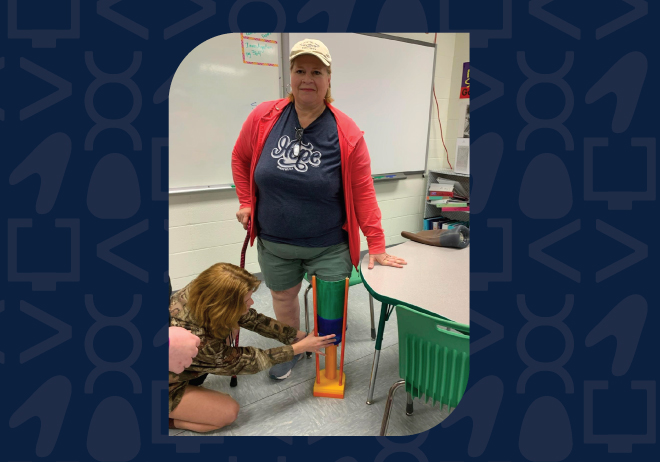Lesa Hall, a former teacher of 17 years in West Plains, Missouri, had a problem that needed solving. After having her leg amputated in 2021, she needed a prosthetic limb that she could use in the shower. Although her below the knee prosthetic leg could get wet, the cleaning process was very time-consuming, and a specialized prosthetic for bathing purposes was costly and not covered through insurance. Lesa chose to engage a fellow educator, Kim Wilson, and employ the brains of Kim’s two PLTW Gateway classes. Kim was onboard and the eager students had a solution.
PLTW Gateway curriculum intentionally engages students in activities that build knowledge and skills embedded into real-world problems and allow students to explore various career opportunities. Because of that connection to career and the focus on providing students those unique experiences to apply learning, Lesa and Kim thought this would be an ideal project for the STEM classes.
In January 2022, the class, which was over 50 percent girls, set to work. First, they met with Lesa to learn more about her needs and to design the parameters of the project. They asked her questions about the must-haves and the must-avoids, and took detailed measurements. They came away with a scope of work for a “shower leg” that was waterproof, light weight, comfortable (fit appropriately and utilized a gel pad), and durable. Then they did extensive research to understand what more they needed to know about the product they were tasked with creating.
From there they set out to create a prototype. This was one phase that many students expressed was their favorite. Utilizing Sketchup, a 3D modeling software for drawing and designing, they identified the key components of the product. They knew it needed a suspension or a physical attachment to the body, an interface and socket, components, and a foot. They used wood, foam, cardboard, and (highly coveted) Barbie duct tape to fabricate a mockup of the prosthetic. Then came the first true test of their work - Lesa came to the classroom to test the prototype. The students and teachers were elated to see that the measurements were perfect, and they could move onto their next phase of creating the actual prosthetic.
The initial hurdle came with identifying the appropriate production materials. Relying on their gathered criteria, the students knew it needed to be waterproof, durable, and lightweight. Ideally, they would print a majority of the product on the 3D printer they had access to in class, but the printer was too small to accommodate the needed size.
“We couldn’t print the whole thing because our 3D printer wasn’t big enough. We needed to find some sort of material that would work as well and that’s when I came up with the idea of using PVC pipe because it is durable and it’s waterproof.” Natalie, a student in Kim’s class said. The students decided the best design would use a combination of that PVC piping along with 3D printed materials, elastic, and stainless-steel screws to create the final product.
The students wanted to make sure that Lesa not only had a functional leg but also one that was reflective of her personal style. They decided the solution was to add color. This led to one of many, and maybe the most memorable, failures. The class tried to dye the prosthetic leg and encountered issue after issue with color saturation but, persevering, they produced a very vibrant leg. They then focused on the construction of the foot where they chose to emphasize the “aquatic” theme with the water safe prosthetic, choosing to use a large orange plastic ducks’ foot. The students refined the foot, measuring, rechecking, and calibrating as they found and eliminated issues, including sharp edges that may cut or hurt the user.
“It’s okay to fail your first time through.” Kim reflected on how she guided her PLTW Gateway students through the challenges they would face while working in the curriculum and, ultimately, challenges they will experience through their careers. “‘You guys are going to fail and it is okay.’ They have learned to fail and redo and redo.”
The class presented Lesa with her new shower leg in April 2022, which gained some media attention. In an interview with Nate Hudson for Ozark Radio News she said, “They will never know how much an item like this is appreciated. When you become an amputee, you don’t think about all the small things that are going to change in your life. By these students out of Fairview designing and creating this 3D shower leg for me, it’s going to make a complete difference in my everyday life.”
Now that these young minds have the success, and confidence, of this real-world solution under their belts, we can’t wait to see what else they can achieve and the other solutions they will provide. We also wanted to take a moment to thank and celebrate Kim Wilson for her commitment to all her students. Kim is celebrating her retirement this year after 24 years teaching at Fairview.
__
PLTW provides PreK-12 schools, teachers, and students with hands-on, interdisciplinary STEM-based curriculum that uniquely prepares students for life and their future careers.
PLTW rejuvenates teachers, providing world-class experiences that keep them on the forefront of how to prepare students for the demands of tomorrow. PLTW:
Has provided professional development opportunities to more than 80,000 teachers giving them the support and resources needed to inspire students
- Offers best-in-class teacher training: PLTW Core Training with Master Teachers
- Continuously updates teacher resources that are available on demand
- Facilitates teacher networking opportunities
- Develops curriculum by a team of writers, many of whom are former teachers
Learn more about PLTW on pltw.org


